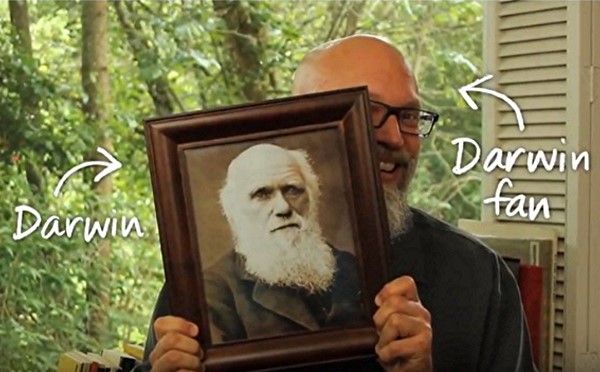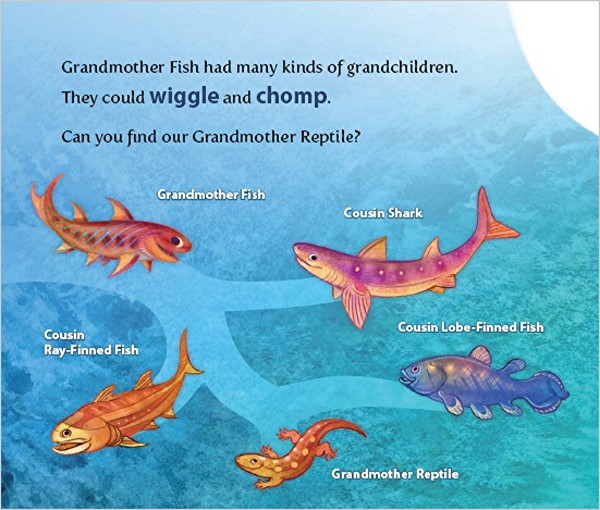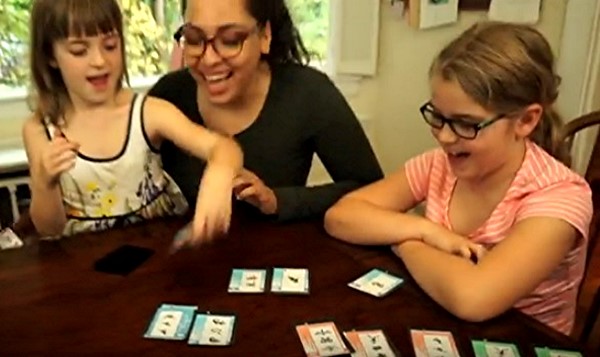Grandmother Fish: book review
Once upon a time (now, in fact), there lived a man named Jonathan Tweet. Mr. Tweet was a professional game designer. Even though they lived many years apart, Mr. Tweet was also a good friend of Charles Darwin. Mr. Tweet was jealous of Mr. Darwin’s wonderful beard,

but he especially admired Mr. Darwin for explaining why there are so many different kinds of plants and animals. Mr. Tweet thought that Mr. Darwin’s explanation was so important that he decided to write a book, Grandmother Fish,

to explain Mr. Darwin’s theory to children like you. Mr. Tweet enlisted Karen Lewis, another friend of Mr. Darwin, to illustrate his book. Ms. Lewis does not have a beard and is not jealous of Mr. Darwin.
To make sure he got the explanation exactly right, Mr. Tweet enlisted the help of several scientists, but especially Eric Meikle, then of the National Center for Science Education. If your parents ever want to make a contribution to NCSE, I suggest that you encourage them.
Mr. Darwin was a naturalist – someone who observes the world around him very closely – and he concluded that a certain fish, which Mr. Tweet calls Grandmother Fish, had many, many, many great-great-great-great-etc.-grandchildren. These great-great-great-great-etc.-grandchildren differed so much from one another and also from their great-great-great-great-etc.-grandmother that today we consider them different kinds of fish.

Some of the great-great-great-great-etc.-grandchildren differed so much from the other great-great-great-great-etc.-grandchildren that we do not think of them as fish at all. Can you find the reptile in the figure? That Grandmother Reptile is the great-great-great-great-etc.-grandmother of many, many, many great-great-great-great-etc.-grandchildren who differ so much from each other that we consider them different kinds of reptile.
One of the many great-great-great-great-etc.-grandchildren of Grandmother Reptile was Grandmother Mammal, and you are one of her many, many, many great-great-great-great-etc.-grandchildren. To find out more, I’m afraid you’ll have to go down to your nearest independent bookstore and buy Mr. Tweet and Ms. Lewis’s splendid book.
While Mr. Tweet was researching Grandmother Fish, he learned about clades. A clade is a group of plants or animals that have the same Grandmother. To help you understand about clades, Mr. Tweet enlisted his friend, Ms. Lewis, to illustrate two card games he developed, Clades, the Evolutionary Card Game, and Clades: Prehistoric.

- - - - - -
Appendix. For any parents who are still reading, Mr. Tweet provides a useful appendix which explains concepts such as descent with modification and natural selection, a page called “A Guide to the Grandmothers, Their Actions, And Their Grandchildren,” and a page on correcting common errors. One of the errors is, “We descended from one fish or pair of fish, or one early human or pair of early humans.” Whereas that is indeed an error, it is arguably an error that is propagated in this very book; I thought perhaps he needed to expand somewhat on that topic.
Finally, with permission, I forwarded a PDF of the book to Donna Young, My Very Favorite Kindergarten Teacher Ever. Ms. Young does nothing halfway and provided me with the following comments, which I reproduce here, also with permission:
Interesting!
Definitely geared toward toddler and preschool kids.
Here’s what I think:
I like the clear, simple, colorful illustrations. Young children are drawn to illustrations like these.
I really like how the author asks kids to move like the animals in the books. That always adds to the engagement and enjoyment of the book. Also helps little ones to make connections.
Upon first reading the book, it was confusing how each grandmother is connected. The book makes huge jumps from one grandmother to the next without saying something like, “after a long time” or “many, many years passed.” If I was a young child, I’m not sure I would make the connections between the different grandmothers and I would be confused how a fish grandmother could have a reptile grandchild.
The illustrations do represent the “grandchildren,” but parents may not help children understand the connections/relationships. Parents may not know!
The notes at the end are very helpful and suggest good talking points for adults to use with children. Perhaps it would be helpful to have those at the beginning of the book or at least have an author’s note explaining that there are references at the back of the book that can be used to explain evolution to young children.
I really like how the author highlights “rich” words – the important words that help children understand the concept and build vocabulary. When we write in kindergarten, we use a black marker and highlight rich words in red marker.
I like the clear and simple labels. This helps kids learn about labels and captions.
The format is similar to other known preschool books so many children and parents will be familiar with a “building” story (e.g., The House That Jack Built, The Napping House, Boots).
At the end when it says “and I see one of them right here” – that is confusing because there are many humans, not just one. It would be fun to have a safety mirror at the end of the book so when children look at the last page and reads “I see one of them right here,” they would see themselves and that would help make more connections between them and the text (text-to-self connection) and also a connection to how they fit into the concept of evolution.
- - - - - -
